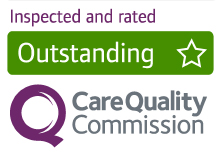Downloaded from www.mymenopausecentre.com
Direct URL: https://www.mymenopausecentre.com/gp-resources/understanding-endometriosis/
Understanding endometriosis
In this patient information leaflet My Menopause Centre's Dr Abbie Laing and Dr Clare Spencer explain what endometriosis is, symptoms, diagnosis and management, what happens to endometriosis after the menopause and how HRT (Hormone Replacement Therapy) can impact endometriosis.
Explore
Book an appointment
The highly experienced doctors and nurses in our menopause clinic are here to help you. Appointments from £190.
Book An AppointmentWhat is endometriosis?
The lining of the womb is called the endometrium. This reacts to the hormones oestrogen and progesterone released by the ovaries and if a woman does not become pregnant it is shed each month as a period.
Endometriosis is a condition where tissue that is similar to the endometrium grows in other places outside of the womb, for example on the ovaries, the wall of the pelvis and even the bowel or the bladder. Like the endometrium, endometriosis tissue also goes through a monthly cycle. However, because it is present outside the womb, there is no place for any blood to leave and this can cause cyclical pains and discomfort.
Endometriosis is a benign condition meaning it is not cancerous.
Where can endometriosis be found?
Places where endometriosis might grow include:
- The ovary
- The fallopian tubes
- The ligaments supporting the womb
- Located on organs within the tummy (abdomen) such as the bladder, bowel or diaphragm
- Very rarely it is even found in the lungs
What causes endometriosis?
The cause of endometriosis is not known. One possible cause is that blood flows the wrong way during a period (retrograde menstruation) which can seed endometrium into different places in the body. It appears that there is also a genetic predisposition in some women, so it can run in families.
What symptoms does endometriosis cause?
Some women with endometriosis have no symptoms at all and it is found incidentally, for example during scans for other reasons, or during surgery for another cause such as having your appendix removed. For other women symptoms can be severe and include:
- Tummy pains that are usually worse in the lead-up or first few days of a period
- Pain during sex
- Pain when passing urine or opening bowels
- Blood in the urine or stool
- Infertility – although not everyone who has endometriosis has difficulty becoming pregnant
How is endometriosis diagnosed?
It is difficult to identify endometriosis on scans and for this reason, it is hard to diagnose. It can also present in a similar way to many other conditions. On average it takes 7.5 years from onset of symptoms to get a diagnosis of endometriosis.
The only reliable diagnostic test is a laparoscopy, which means looking inside your tummy with a small camera. This procedure is not without risk, however, and many women are given treatment for endometriosis without having a laparoscopy.
If you think that you have symptoms of endometriosis you should discuss these with your healthcare practitioner.
How can endometriosis be treated?
With the right treatment, many women find their symptoms are managed well. Medical treatments usually focus on reducing oestrogen levels because this hormone can make endometriosis deposits grow. Giving progestogen hormones in the form of the mini pill (progesterone only pill), Mirena ‘coil’, contraceptive implant and Depot Provera contraceptive injection can also help in managing endometriosis.
Endometriosis may be surgically removed. Lesions can be excised using laser or diathermy, usually by key hole surgery. A combination of medical and surgical management may be required for some women.
Some women who have completed their families do consider hysterectomy at the time of surgical treatment of endometriosis if there are other reasons for this – for example adenomysosis or heavy vaginal bleeding that has not responded to other treatments. Hysterectomy would only occur after careful discussion about the risks and benefits.
What happens to endometriosis after the menopause?
Symptoms of endometriosis after the menopause usually improve due to the declining levels of oestrogen. For many women who have struggled with symptoms, this comes as a relief. The decision therefore whether to start hormone replacement therapy (HRT) can feel daunting.
It would be unusual for women to suddenly develop endometriosis in the menopause but it is possible. It is not clear whether endometriosis in the postmenopause represents a recurrence or endometriosis which has been there all the time or the development of brand-new endometriosis. It is possible that the endometriosis may have been present for many years and only discovered at the time of the menopause during investigation for other symptoms.
Can HRT reactivate or worsen endometriosis?
To answer this question, it is important to understand how the two hormones, oestrogen and progesterone which are prescribed in HRT, can affect endometriosis:
- Oestrogen can, in some women, stimulate endometriosis deposits to grow.
- Progestogens however work in the opposite way and suppress the stimulatory effect of oestrogens on endometriosis deposits. This is one of the reasons progestogens are used as treatment options for endometriosis.
This means that any risk of endometriosis being reactivated by HRT depends on the balance between these two hormones and, for most women, the combination of a low dose oestrogen with a daily progestogen, represents a regime that will not stimulate or reactive endometriosis. This is because the daily progestogen usually provides adequate suppression of the endometriosis itself.
When HRT is prescribed as an oestrogen with a daily progestogen this is called a continuous combined regime and usually, this type of HRT is prescribed if you have endometriosis.
It is important to know that a recurrence of endometriosis is possible, even in the absence of HRT.
If I have had a hysterectomy does this change things?
If you have had a hysterectomy at the time of surgical treatment of endometriosis, you may still be advised to take a daily progestogen, particularly if your endometriosis was extensive. This is because, as mentioned above, endometriosis tissue can grow in places outside of the womb and it will still be present in these places after the womb has been removed. A daily progestogen will prevent these deposits from growing in response to oestrogen.
Occasionally, some surgeons feel certain that they have fully removed all of an individual’s endometriosis. This can occur in cases where the endometriosis was very mild or clearly confined to one area only. In these cases, the use of oestrogen-only HRT is sometimes considered. However, if there is any uncertainty, then a progestogen should be used too.
Can the Mirena coil be used as the progestogen?
A Mirena, or equivalent levonorgestrel intrauterine system, is often offered as a treatment for endometriosis. It releases a low level of progestogen and is an option for reducing the symptom of pain. Other progesterone-only forms of contraception and the combined oral contraceptive may be discussed also as management options. The advantage of the Mirena or equivalent is that this can also be used as the progestogen arm of HRT.
Is there a risk that HRT might stimulate endometriosis to turn into a cancer?
There have only ever been a few case reports of this and the consensus among guidelines is that this is likely to be very rare. Of those few case reports that are available they were mostly in women who took oestrogen-only HRT.
Dr Clare explains:
Authored by:
Dr Abbie Laing
Authored by:
Dr Clare Spencer
Registered menopause specialist, GP and co-founder; see Dr Clare in person at The Spire Hospital, Leeds or online
Last updated:
22/03/2024
Book an appointment
The highly experienced doctors and nurses in our menopause clinic are here to help you. Appointments from £190.
Book An AppointmentJoin the pause. community
We’ve created pause. as a space for women to come together and share stories about their menopause experience, ask questions, and to find support and inspiration. We'll also share the latest news and updates on the menopause from our experts.
Want to be the first to hear our latest news? Join our pause. community today.
Share your email to receive the latest news, updates and information on new products and treatments from My Menopause Centre and our pause. community. You can unsubscribe at any time.
We're committed to protecting and respecting your privacy - see our Privacy Policy and Terms and Conditions

Book a consultation
Whether you want to discuss your symptoms, create a treatment plan that's right for you, understand some test results or have a check-up, the highly experienced doctors and nurses in our menopause clinic are here to help you.
Book nowReferences
-
National Institute of Clinical Excellence (NICE) Clinical Knowledge Summaries. Endometriosis. Last revised February 2020.
-
Endometriosis. Guidelines of European Society of Human Reproduction and Embryology (ESHRE guideline). ESHRE endometriosis guideline development group. 2022.
-
https://www.eshre.eu/Guideline/Endometriosis
Contact My Menopause Centre
- General enquiries: hello@mymenopausecentre.com
- Book appointments online: Log into your account and go to 'My appointments'
- Book appointments by phone: 0333 444 1067
- Website: https://www.mymenopausecentre.com


















